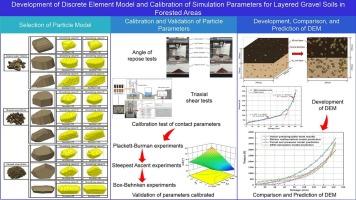林区层状砾石土壤离散元素模型的开发与校准
IF 4.5
2区 工程技术
Q2 ENGINEERING, CHEMICAL
引用次数: 0
摘要
本文开发了一种离散元素法(DEM)模型,用于精确模拟林业机械车辆与林层砾石土壤之间的相互作用。DEM 模型中的土粒模拟为球形颗粒,而砾石则根据实际的砾石含量、大小和形状由九种类型的非球形颗粒群来表示。DEM 模型参数通过室内静止角 (AOR) 和三轴剪切试验进行校准,然后使用 Plackett-Burman、Steepest Ascent 和 Box-Behnken 试验进行统计校准。根据获得的二次回归分析结果,确定最佳 DEM 模型参数值。最后,通过比较室内测试结果与 DEM 模拟输出和数学预测,验证了 MED 模型的准确性。结果表明,DEM 模型模拟曲线与测量值非常吻合,显示出良好的一致性。本文章由计算机程序翻译,如有差异,请以英文原文为准。

Development and calibration of discrete element model for layered gravel soils in forested areas
In this paper, a Discrete Element Method (DEM) model is developed to accurately simulate the interaction between forestry machinery vehicles and forest-layered gravel soils. The soil grains in the DEM model are simulated as spherical particles, while the gravel is represented by nine types of non-spherical particle clusters based on the actual gravel content, size, and shape. The DEM model parameters are calibrated through the indoor angle of repose (AOR) and triaxial shear tests, followed by statistical calibration using Plackett-Burman, Steepest Ascent, and Box-Behnken experiments. The values of the optimal DEM model parameters are determined based on the obtained quadratic regression analysis. Finally, the MED model accuracy is verified by comparing indoor test results with the DEM simulation outputs and mathematical predictions. The results revealed that the DEM model simulated curves closely match the measured values, indicating good agreement.
求助全文
通过发布文献求助,成功后即可免费获取论文全文。
去求助
来源期刊

Powder Technology
工程技术-工程:化工
CiteScore
9.90
自引率
15.40%
发文量
1047
审稿时长
46 days
期刊介绍:
Powder Technology is an International Journal on the Science and Technology of Wet and Dry Particulate Systems. Powder Technology publishes papers on all aspects of the formation of particles and their characterisation and on the study of systems containing particulate solids. No limitation is imposed on the size of the particles, which may range from nanometre scale, as in pigments or aerosols, to that of mined or quarried materials. The following list of topics is not intended to be comprehensive, but rather to indicate typical subjects which fall within the scope of the journal's interests:
Formation and synthesis of particles by precipitation and other methods.
Modification of particles by agglomeration, coating, comminution and attrition.
Characterisation of the size, shape, surface area, pore structure and strength of particles and agglomerates (including the origins and effects of inter particle forces).
Packing, failure, flow and permeability of assemblies of particles.
Particle-particle interactions and suspension rheology.
Handling and processing operations such as slurry flow, fluidization, pneumatic conveying.
Interactions between particles and their environment, including delivery of particulate products to the body.
Applications of particle technology in production of pharmaceuticals, chemicals, foods, pigments, structural, and functional materials and in environmental and energy related matters.
For materials-oriented contributions we are looking for articles revealing the effect of particle/powder characteristics (size, morphology and composition, in that order) on material performance or functionality and, ideally, comparison to any industrial standard.
 求助内容:
求助内容: 应助结果提醒方式:
应助结果提醒方式:


